Dorien Herremans
Singapore University of Technology and Design
JamendoMaxCaps: A Large Scale Music-caption Dataset with Imputed Metadata
Feb 11, 2025Abstract:We introduce JamendoMaxCaps, a large-scale music-caption dataset featuring over 200,000 freely licensed instrumental tracks from the renowned Jamendo platform. The dataset includes captions generated by a state-of-the-art captioning model, enhanced with imputed metadata. We also introduce a retrieval system that leverages both musical features and metadata to identify similar songs, which are then used to fill in missing metadata using a local large language model (LLLM). This approach allows us to provide a more comprehensive and informative dataset for researchers working on music-language understanding tasks. We validate this approach quantitatively with five different measurements. By making the JamendoMaxCaps dataset publicly available, we provide a high-quality resource to advance research in music-language understanding tasks such as music retrieval, multimodal representation learning, and generative music models.
ImprovNet: Generating Controllable Musical Improvisations with Iterative Corruption Refinement
Feb 06, 2025Abstract:Deep learning has enabled remarkable advances in style transfer across various domains, offering new possibilities for creative content generation. However, in the realm of symbolic music, generating controllable and expressive performance-level style transfers for complete musical works remains challenging due to limited datasets, especially for genres such as jazz, and the lack of unified models that can handle multiple music generation tasks. This paper presents ImprovNet, a transformer-based architecture that generates expressive and controllable musical improvisations through a self-supervised corruption-refinement training strategy. ImprovNet unifies multiple capabilities within a single model: it can perform cross-genre and intra-genre improvisations, harmonize melodies with genre-specific styles, and execute short prompt continuation and infilling tasks. The model's iterative generation framework allows users to control the degree of style transfer and structural similarity to the original composition. Objective and subjective evaluations demonstrate ImprovNet's effectiveness in generating musically coherent improvisations while maintaining structural relationships with the original pieces. The model outperforms Anticipatory Music Transformer in short continuation and infilling tasks and successfully achieves recognizable genre conversion, with 79\% of participants correctly identifying jazz-style improvisations. Our code and demo page can be found at https://github.com/keshavbhandari/improvnet.
Towards Unified Music Emotion Recognition across Dimensional and Categorical Models
Feb 06, 2025Abstract:One of the most significant challenges in Music Emotion Recognition (MER) comes from the fact that emotion labels can be heterogeneous across datasets with regard to the emotion representation, including categorical (e.g., happy, sad) versus dimensional labels (e.g., valence-arousal). In this paper, we present a unified multitask learning framework that combines these two types of labels and is thus able to be trained on multiple datasets. This framework uses an effective input representation that combines musical features (i.e., key and chords) and MERT embeddings. Moreover, knowledge distillation is employed to transfer the knowledge of teacher models trained on individual datasets to a student model, enhancing its ability to generalize across multiple tasks. To validate our proposed framework, we conducted extensive experiments on a variety of datasets, including MTG-Jamendo, DEAM, PMEmo, and EmoMusic. According to our experimental results, the inclusion of musical features, multitask learning, and knowledge distillation significantly enhances performance. In particular, our model outperforms the state-of-the-art models, including the best-performing model from the MediaEval 2021 competition on the MTG-Jamendo dataset. Our work makes a significant contribution to MER by allowing the combination of categorical and dimensional emotion labels in one unified framework, thus enabling training across datasets.
Text2midi: Generating Symbolic Music from Captions
Dec 21, 2024Abstract:This paper introduces text2midi, an end-to-end model to generate MIDI files from textual descriptions. Leveraging the growing popularity of multimodal generative approaches, text2midi capitalizes on the extensive availability of textual data and the success of large language models (LLMs). Our end-to-end system harnesses the power of LLMs to generate symbolic music in the form of MIDI files. Specifically, we utilize a pretrained LLM encoder to process captions, which then condition an autoregressive transformer decoder to produce MIDI sequences that accurately reflect the provided descriptions. This intuitive and user-friendly method significantly streamlines the music creation process by allowing users to generate music pieces using text prompts. We conduct comprehensive empirical evaluations, incorporating both automated and human studies, that show our model generates MIDI files of high quality that are indeed controllable by text captions that may include music theory terms such as chords, keys, and tempo. We release the code and music samples on our demo page (https://github.com/AMAAI-Lab/Text2midi) for users to interact with text2midi.
MIRFLEX: Music Information Retrieval Feature Library for Extraction
Nov 01, 2024
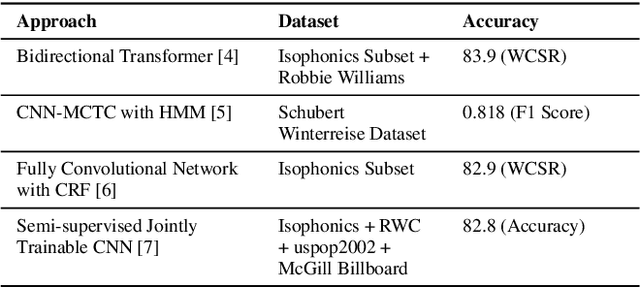

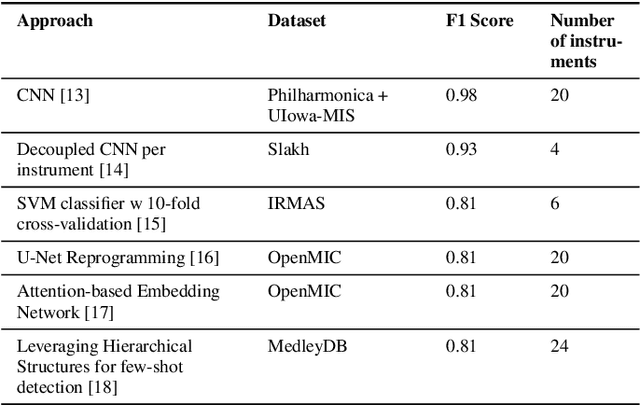
Abstract:This paper introduces an extendable modular system that compiles a range of music feature extraction models to aid music information retrieval research. The features include musical elements like key, downbeats, and genre, as well as audio characteristics like instrument recognition, vocals/instrumental classification, and vocals gender detection. The integrated models are state-of-the-art or latest open-source. The features can be extracted as latent or post-processed labels, enabling integration into music applications such as generative music, recommendation, and playlist generation. The modular design allows easy integration of newly developed systems, making it a good benchmarking and comparison tool. This versatile toolkit supports the research community in developing innovative solutions by providing concrete musical features.
DART: Disentanglement of Accent and Speaker Representation in Multispeaker Text-to-Speech
Oct 17, 2024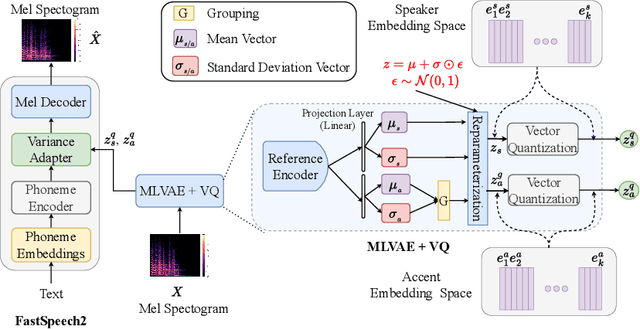
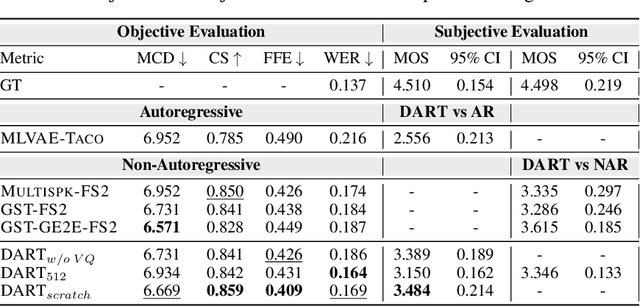
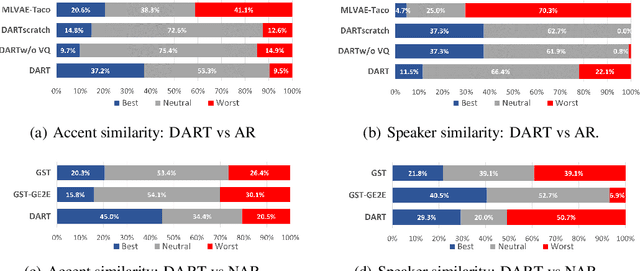

Abstract:Recent advancements in Text-to-Speech (TTS) systems have enabled the generation of natural and expressive speech from textual input. Accented TTS aims to enhance user experience by making the synthesized speech more relatable to minority group listeners, and useful across various applications and context. Speech synthesis can further be made more flexible by allowing users to choose any combination of speaker identity and accent, resulting in a wide range of personalized speech outputs. Current models struggle to disentangle speaker and accent representation, making it difficult to accurately imitate different accents while maintaining the same speaker characteristics. We propose a novel approach to disentangle speaker and accent representations using multi-level variational autoencoders (ML-VAE) and vector quantization (VQ) to improve flexibility and enhance personalization in speech synthesis. Our proposed method addresses the challenge of effectively separating speaker and accent characteristics, enabling more fine-grained control over the synthesized speech. Code and speech samples are publicly available.
Leveraging LLM Embeddings for Cross Dataset Label Alignment and Zero Shot Music Emotion Prediction
Oct 15, 2024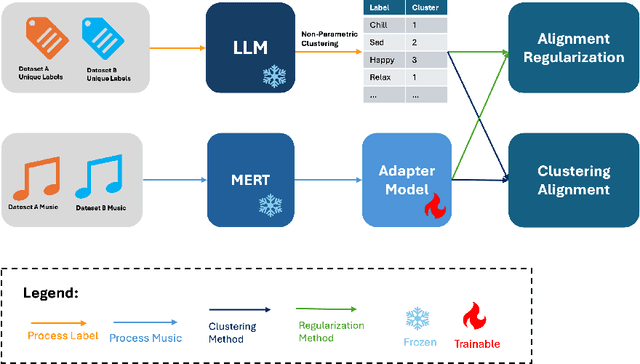

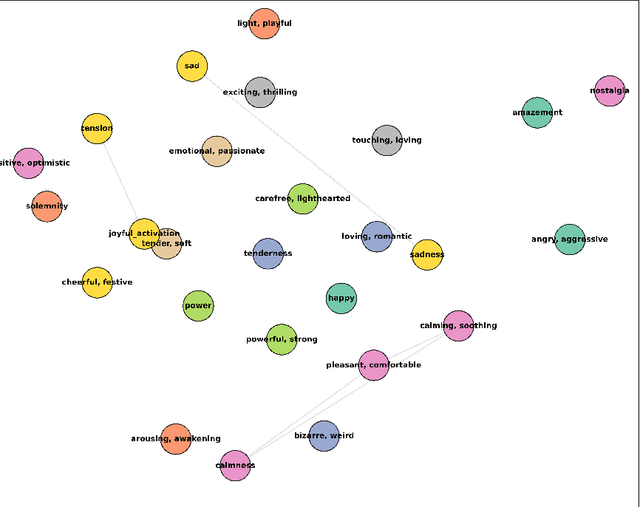

Abstract:In this work, we present a novel method for music emotion recognition that leverages Large Language Model (LLM) embeddings for label alignment across multiple datasets and zero-shot prediction on novel categories. First, we compute LLM embeddings for emotion labels and apply non-parametric clustering to group similar labels, across multiple datasets containing disjoint labels. We use these cluster centers to map music features (MERT) to the LLM embedding space. To further enhance the model, we introduce an alignment regularization that enables dissociation of MERT embeddings from different clusters. This further enhances the model's ability to better adaptation to unseen datasets. We demonstrate the effectiveness of our approach by performing zero-shot inference on a new dataset, showcasing its ability to generalize to unseen labels without additional training.
Prevailing Research Areas for Music AI in the Era of Foundation Models
Sep 14, 2024Abstract:In tandem with the recent advancements in foundation model research, there has been a surge of generative music AI applications within the past few years. As the idea of AI-generated or AI-augmented music becomes more mainstream, many researchers in the music AI community may be wondering what avenues of research are left. With regards to music generative models, we outline the current areas of research with significant room for exploration. Firstly, we pose the question of foundational representation of these generative models and investigate approaches towards explainability. Next, we discuss the current state of music datasets and their limitations. We then overview different generative models, forms of evaluating these models, and their computational constraints/limitations. Subsequently, we highlight applications of these generative models towards extensions to multiple modalities and integration with artists' workflow as well as music education systems. Finally, we survey the potential copyright implications of generative music and discuss strategies for protecting the rights of musicians. While it is not meant to be exhaustive, our survey calls to attention a variety of research directions enabled by music foundation models.
PRESENT: Zero-Shot Text-to-Prosody Control
Aug 13, 2024Abstract:Current strategies for achieving fine-grained prosody control in speech synthesis entail extracting additional style embeddings or adopting more complex architectures. To enable zero-shot application of pretrained text-to-speech (TTS) models, we present PRESENT (PRosody Editing without Style Embeddings or New Training), which exploits explicit prosody prediction in FastSpeech2-based models by modifying the inference process directly. We apply our text-to-prosody framework to zero-shot language transfer using a JETS model exclusively trained on English LJSpeech data. We obtain character error rates (CER) of 12.8%, 18.7% and 5.9% for German, Hungarian and Spanish respectively, beating the previous state-of-the-art CER by over 2x for all three languages. Furthermore, we allow subphoneme-level control, a first in this field. To evaluate its effectiveness, we show that PRESENT can improve the prosody of questions, and use it to generate Mandarin, a tonal language where vowel pitch varies at subphoneme level. We attain 25.3% hanzi CER and 13.0% pinyin CER with the JETS model. All our code and audio samples are available online.
BandControlNet: Parallel Transformers-based Steerable Popular Music Generation with Fine-Grained Spatiotemporal Features
Jul 15, 2024Abstract:Controllable music generation promotes the interaction between humans and composition systems by projecting the users' intent on their desired music. The challenge of introducing controllability is an increasingly important issue in the symbolic music generation field. When building controllable generative popular multi-instrument music systems, two main challenges typically present themselves, namely weak controllability and poor music quality. To address these issues, we first propose spatiotemporal features as powerful and fine-grained controls to enhance the controllability of the generative model. In addition, an efficient music representation called REMI_Track is designed to convert multitrack music into multiple parallel music sequences and shorten the sequence length of each track with Byte Pair Encoding (BPE) techniques. Subsequently, we release BandControlNet, a conditional model based on parallel Transformers, to tackle the multiple music sequences and generate high-quality music samples that are conditioned to the given spatiotemporal control features. More concretely, the two specially designed modules of BandControlNet, namely structure-enhanced self-attention (SE-SA) and Cross-Track Transformer (CTT), are utilized to strengthen the resulting musical structure and inter-track harmony modeling respectively. Experimental results tested on two popular music datasets of different lengths demonstrate that the proposed BandControlNet outperforms other conditional music generation models on most objective metrics in terms of fidelity and inference speed and shows great robustness in generating long music samples. The subjective evaluations show BandControlNet trained on short datasets can generate music with comparable quality to state-of-the-art models, while outperforming them significantly using longer datasets.
 Add to Chrome
Add to Chrome Add to Firefox
Add to Firefox Add to Edge
Add to Edge